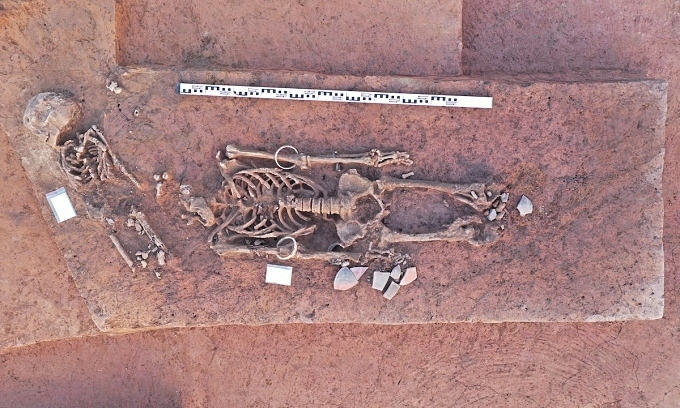4,000-year-old cemetery unearthed in Hanoi
An excavation team from the Vietnam Institute of Archeology, Hanoi Museum, and the University of Social Sciences and Humanities, Hanoi, recently announced the discovery of more than 70 pre-Dong Son burials (approximately 4,000 years old) and 40 Dong Son burials (around 2,500 years old) at the site in Kim Chung Commune, Hoai Duc District.
The excavation, conducted from late March until early this month, covered an area of over 6,000 square meters with 60 research pits, each measuring 100 square meters.
Archaeological findings suggest that Vuon Chuoi was a village settled and dominated by people from the Metal Age, which began about 6,000 years ago. During this period, people started using metals like copper, tin, bronze, and iron to craft tools and weapons.
The village continuously developed from the late Phung Nguyen period (about 4,000 years ago) through the post-Dong Son period.
The findings also indicate early human presence in the Hanoi area, confirming the indigenous origins and deep history of the Vietnamese ethnic groups dating back to prehistoric times.
Professor Dr. Lam Thi My Dung, from the University of Social Sciences and Humanities and a member of the team, noted that while isolated graves had been found in residential areas before, this is the first discovery of a distinct cemetery from the pre-Dong Son period.
“The relatively well-preserved skeletons allow us to trace the continuity and changes in burial practices of ancient peoples. By analyzing the skeletal data, we can establish the genetic lineage of these ancient populations and compare it with modern humans, helping to trace our origins,” Dung said.
Archaeologists work at the Vuon Chuoi site in Hanoi. Photo acquired by Read |
Additionally, archaeologists discovered house posts, suggesting the Dong Son people may have lived in longhouses, similar to those still used by certain ethnic groups in central Vietnam.
“This discovery opens up new possibilities for understanding the housing architecture in ancient Dong Son villages and the layout of residential spaces,” the excavation team stated.
The team has proposed further research on the remaining areas of the site and called for in-depth studies. They have also urged the Hanoi People’s Committee and the Department of Culture and Sports to expedite the recognition of Vuon Chuoi as a city-level heritage site, while developing plans for its preservation, protection, and value enhancement.
First discovered in 1969, the Vuon Chuoi site has undergone 11 excavation phases. Archaeologists regard it as a rare and valuable site from the Metal Age in northern Vietnam.


Comments are closed.